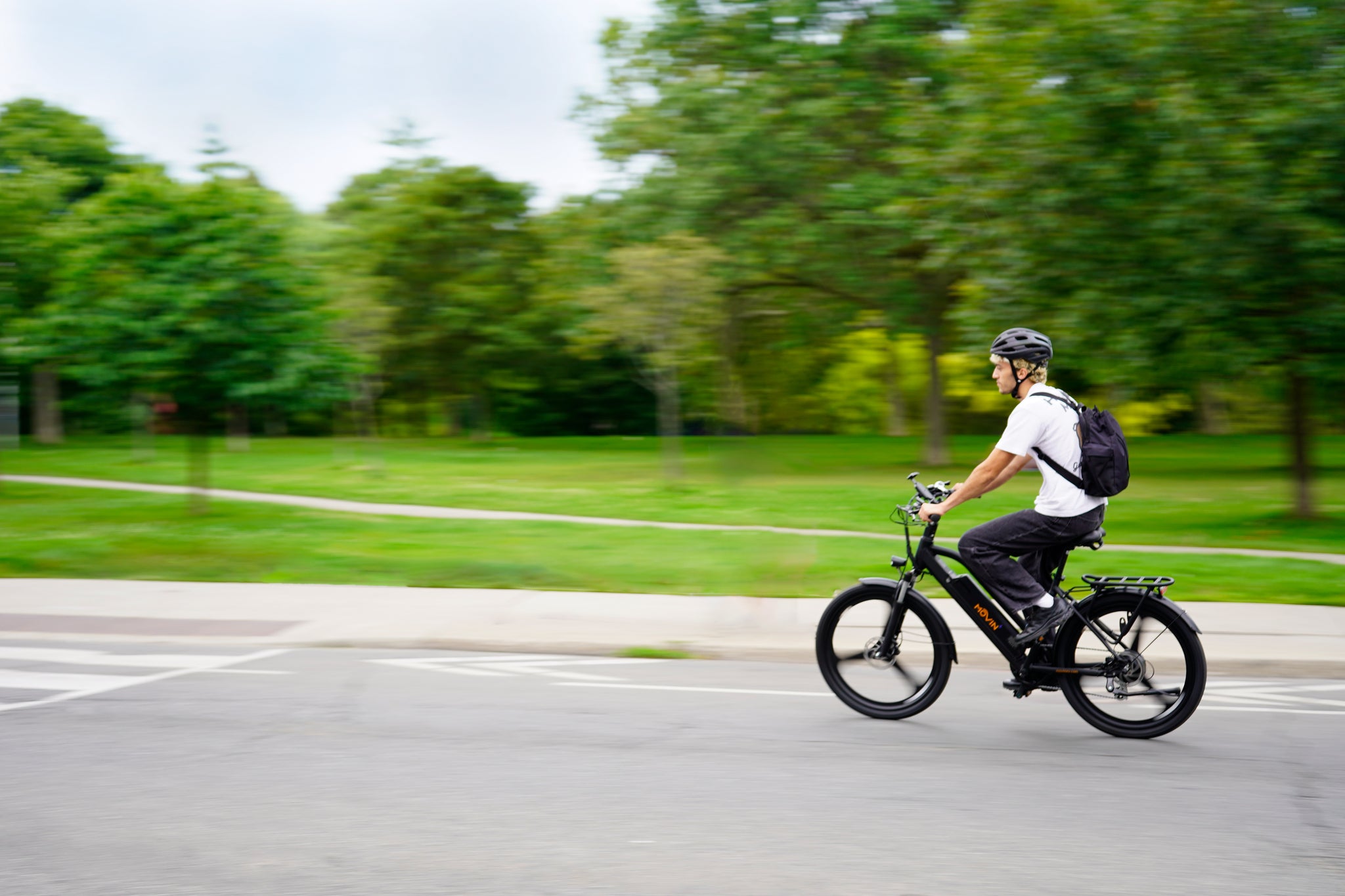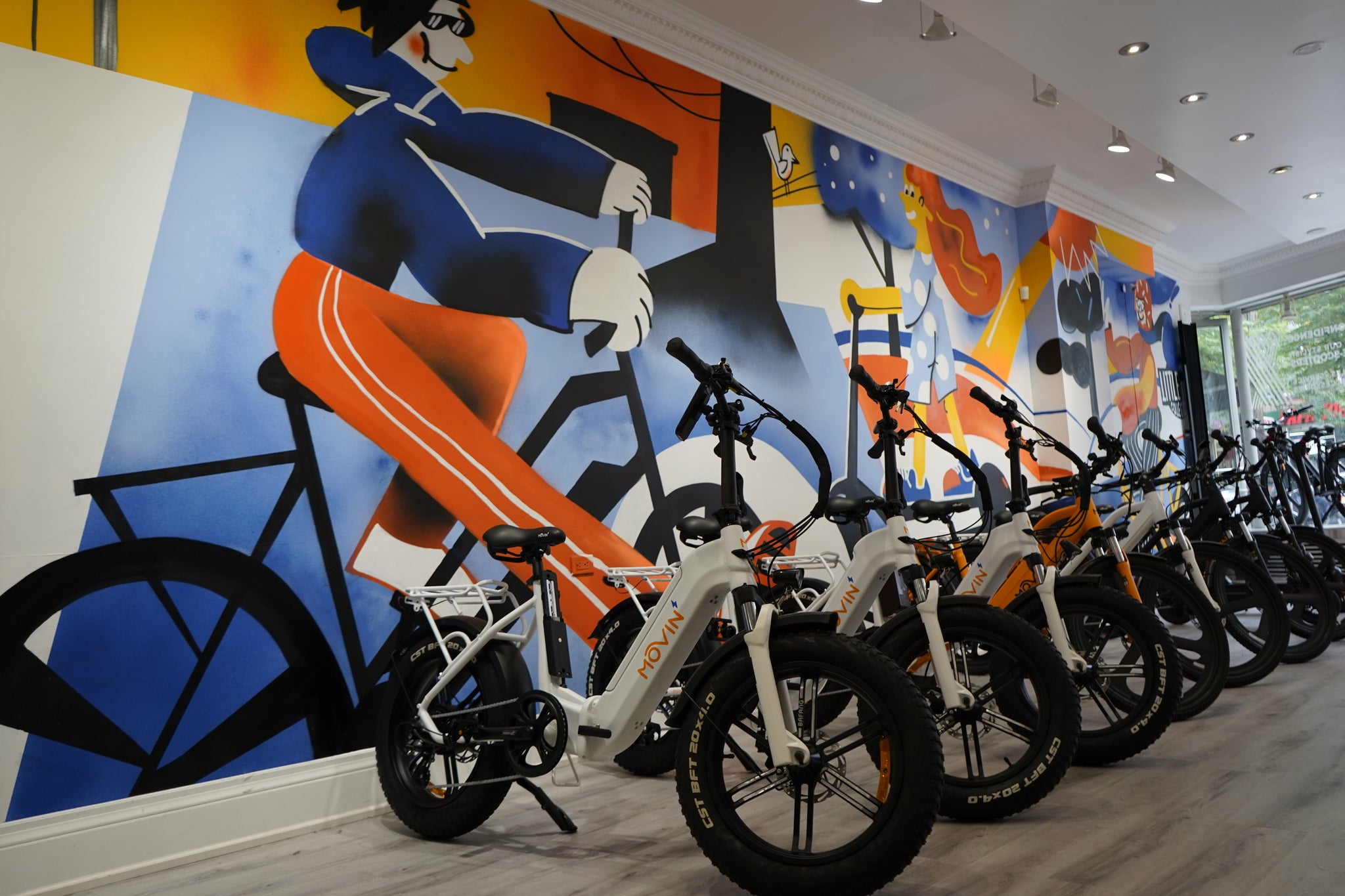Over the past decade, and especially since the COVID-19 pandemic, e-bikes have taken North America by storm, becoming a very popular way to get around or just go on adventures! This is for good reason: they are great for commuting, exercise, environmentally friendly, versatile, and can save you time and money. With the increased usage of e-bikes comes e-bike etiquette. Bike riding etiquette is just like driving a car: there are certain rules, both written and unwritten, that must be followed so that you are being as safe as you can be and courteous to others around you.
Why its necessary to have an ebike
Having an e-bike can bring numerous benefits, making it a necessary addition for many people's lifestyles. Here are key reasons why owning an e-bike can be essential:
1. Environmental Sustainability
- Reduced Carbon Footprint: E-bikes are powered by electricity, significantly reducing the carbon emissions associated with fossil fuel-powered vehicles. They offer a more sustainable alternative for short to medium-distance travel.
2. Health and Fitness
- Low-Impact Exercise: Riding an e-bike provides physical exercise, improving cardiovascular health, and building muscle strength, but with less strain on joints compared to traditional bicycles, making it suitable for a wider range of fitness levels.
- Mental Health Benefits: Regular physical activity, including cycling, has been shown to reduce stress, anxiety, and depression.
3. Cost Efficiency
- Lower Transportation Costs: E-bikes have lower operating costs than cars or public transportation, saving money on fuel, parking, and maintenance.
- Avoid Traffic and Parking Issues: E-bikes can bypass traffic congestion and often have more accessible parking options, saving time and reducing the stress of commuting.
4. Accessibility and Inclusivity
- Suitable for Various Fitness Levels: The pedal assist feature makes cycling accessible to people who may find traditional bikes too physically demanding, including seniors and those recovering from injuries.
- Expands Riding Range: The assistance provided by e-bikes enables riders to cover longer distances more easily, making cycling a viable option for more people and purposes.
5. Urban Mobility
- Ease of Commuting: E-bikes provide a fast and efficient way to navigate through cities, avoiding traffic jams and crowded public transport, which is particularly advantageous during peak hours.
- Supports Multimodal Transportation: E-bikes complement other forms of transportation, such as trains or buses, allowing for more flexible and efficient travel options.
6. Recreational Opportunities
- Enhanced Enjoyment: The assistance from an e-bike can make cycling more enjoyable, especially on challenging terrains such as hills, opening up new opportunities for exploration and leisure.
- Social Engagement: E-biking is an activity that can be enjoyed with friends and family, promoting social interactions and shared experiences.
7. Practicality for Daily Tasks
- Cargo Capacity: Many e-bikes are designed with cargo capacity in mind, making them practical for running errands, grocery shopping, or transporting goods.
8. Technological Advancements
- Innovative Features: Modern e-bikes come equipped with various technological advancements such as GPS navigation, theft protection, and performance tracking, enhancing the riding experience.
9. Legislative Support
- Growing Recognition: Many governments and municipalities are recognizing the benefits of e-bikes, offering incentives, creating bike lanes, and implementing policies to encourage their use.
Owning an e-bike can significantly contribute to a more sustainable, healthy, and enjoyable lifestyle, offering a practical solution to many of the challenges associated with urban transportation.

How to use your ebike
While electric bikes for many people are replacing daily car commutes, it is very important to learn road cycling etiquette to protect yourself and others. This cycling etiquette comes down to a few aspects, including following e-bike laws, using your bells and hand signals properly, ensuring you are visible to drivers and other cyclists, riding safely and slowly, and parking your electric bike correctly. Let’s walk through all of these individually so that you have a thorough understanding of bike riding etiquette for your future rides.
1. Check the Local Electric Bike Laws
As mentioned previously, road biking etiquette is much like driving etiquette: you should not be taking to the street until you have a solid understanding of the proper electric bike laws. This is an important point because laws related to bicycles and electric bikes can differ from country to country, province to province and in some cases, city to city. For example, some places classify electric bikes as motor vehicles that cannot ride on greenways or sidewalks.
Other places do not, and people are encouraged to ride on the sidewalks. These common discrepancies exemplify why you should always check and obey the laws in your local area before riding. If you have any questions, it can also be helpful to contact your local authorities for guidance on the laws in your area. In Ontario, Canada, some of the main e-bike rules are as follows: an e-bike cannot exceed a motor size of 500 watts, and maximum speed cannot exceed 32km/h. You must wear a helmet while riding an e-bike and follow the same rules as cyclists on the roads. Riding on highways and sidewalks is a no-no, but the roads are all yours even if they don’t have bike lanes!
2. Be Seen!
Some cyclists ride at night, whether as part of a commute, because that is the only time to grocery shop or exercise, or simply because they enjoy the peace of nighttime riding. However, cycling at night can be dangerous if car drivers cannot see you. It is imperative to always have reflective objects on your electric bike and also on your body while riding at night, to make it easier for drivers to see you. It's also best to have powerful front and rear lights for maximum visibility. Even if you’re riding in the day, this still holds true ! A good rule of thumb is to always assume that the cars nearby don’t see you, so it’s your responsibility to make sure you keep a safe distance from other cars and make yourself visible with lights/reflective tape or by the use of your horn/bell.3. Use a Bell and/or Horn
Bells and horns exist to help electric bike riders effectively communicate with the people, fellow cyclists and drivers around them so that everyone is remaining safe. It is best to ring your e-bike bell when passing through congested areas so that you are alerting pedestrians, other cyclists, or cars to your presence. This is strictly to ensure their safety and your safety. However, proper cycling etiquette states that you do not ring your bell or sound your horn all the time, as this may irritate people nearby—simply use them when the situation requires it to keep everyone safe.
4. Ride with Both Hands
Sometimes there is a tendency to ride a bike one-handed with more experienced bike and ebike riders. It can be easier, more relaxing, more casual. However, it can also be more dangerous. Oftentimes, that free hand ends up doing something distracting, such as holding a phone or food. Just like driving a car, these types of habits can be highly distracting and also dangerous to both you and the people around you. This is why you should always keep both hands on the handlebars when riding an electric bike. E-bikes are faster than standard bicycles, so accidents can not only easily occur, but they can cause more damage.5. Slow Down Properly
You have probably heard the expression "slow and steady wins the race." Or perhaps when riding with a fast driver someone has uttered, "I'd like to make it there in one piece." While these are a bit cliché, they stand to reason: Driving faster than you should is a dangerous activity that can lead to injury or damage. Following proper road cycling etiquette means taking it slow on your e-bike, always using appropriate speeds to ensure you are being safe for yourself and those around you, especially when you are in a place where many other people or vehicles are present. Ensure to also always keep your hands on the brakes - so you can stop the bike when necessary.
6. Parking
The last thing any electric bike rider wants to do is return to where they locked up their bike only to find that they had not properly secured the lock and their bike is gone. Parking and locking your bike properly is an essential aspect of bike riding etiquette. Typically, there will be a special parking area for electric bikes that is out of the way of normal traffic and does not interfere with any larger motor vehicles. However, parking your e-bike is only the first step. You also need to ensure that it is securely locked.Riding your electric bike safely really does come down to these six helpful pieces of advice. If you can follow e-bike laws, use your bells and hand signals properly, ensure you are visible to drivers and other cyclists at all times, ride safely and slowly, and park your electric bike correctly, you will set yourself apart with your high-quality road cycling etiquette. Now you’re armed with the knowledge to confidently take to the streets and be a courteous e-bike rider.
Step-by-Step Guide to Charging Your Electric Bike
With your electric bike prepared for charging, let's move on to the step-by-step guide for a successful charging session.
Connecting the Charger
Start by plugging the charger into a grounded electrical outlet. Then, locate the charging port on your electric bike and connect the charger to it. Ensure that the connection is firm and secure to avoid any interruptions during the charging process.
Charging Time
Now that your electric bike is connected to the charger, it's time to let the charging process begin. The duration of the charging time will vary depending on the battery's capacity and the charger's specifications. Typically, it takes anywhere from two to ten hours to fully charge a battery e-bike 48v.
During the charging process, it is crucial to monitor the battery's temperature. If it starts to heat up excessively, stop the charging process and seek professional assistance.
Disconnecting the Charger Safely
Once the battery for ebike is fully charged, it is essential to disconnect the charger safely. Start by switching off the power outlet before removing the charger from the charging port. Always handle the charger and the connection cables with care to avoid any damage.

How to choose right ebike
Choosing the right e-bike involves considering your needs, preferences, and the typical conditions in which you'll be riding. Here’s a comprehensive guide to help you make an informed decision:
1. Determine Your Needs
First, identify what you primarily need the e-bike for:
- Commuting: Look for durability, battery range, and features like racks and fenders.
- Recreational Riding: Comfort and ease of use might be your priority, with a focus on ergonomics and simple operation.
- Mountain Biking: You'll need a robust frame, good suspension, and possibly a more powerful motor.
- Cargo Hauling: Consider cargo e-bikes designed with sturdy frames and enhanced carrying capacity.
2. Choose the Right Type of E-Bike
E-bikes come in various styles, each suited to different activities:
- Road E-Bikes: Lightweight and efficient, perfect for paved surfaces.
- Mountain E-Bikes (e-MTBs): Durable with suspension for off-road trails.
- Hybrid/Commuter E-Bikes: A versatile option for both city riding and moderate off-road paths.
- Folding E-Bikes: Great for those with limited storage space or commuters using public transport.
- Cargo E-Bikes: Designed to carry heavy loads, ideal for shopping or dropping kids at school.
3. Motor Type and Placement
- Hub Motor: Positioned in one of the wheels; offers a balanced ride suitable for flat terrains and casual riding.
- Mid-Drive Motor: Located at the bike’s crank; provides a more natural riding feel and better weight distribution, ideal for hilly areas and off-road conditions.
4. Battery Capacity and Range
- Consider the bike’s battery life and whether it meets your daily travel distance. Battery capacity is usually measured in watt-hours (Wh); a higher Wh generally indicates a longer range.
- Keep in mind that factors like rider weight, terrain, and riding style can affect the actual range.
5. Frame Material and Size
- Materials: Aluminum frames are common, offering a good balance between weight and cost. Carbon fiber is lighter but more expensive, while steel is durable and absorbs road vibrations well.
- Size: Ensure the bike fits you. Test ride different models to find one that's comfortable, with easy reach to the handlebars and ground.
6. Braking System
- Mechanical Disc Brakes: Reliable and effective; require manual adjustment.
- Hydraulic Disc Brakes: Offer superior stopping power with less effort; are more expensive but require less maintenance.
7. Suspension
- Front Suspension: Sufficient for most urban and light off-road riding.
- Full Suspension: Best for serious off-road use, providing comfort and control on rough terrain.
8. Gears
- Depending on the terrain, you might prefer a bike with more gears. However, some urban and flat-terrain riders find single-speed or fixed-gear e-bikes simpler and more reliable.
9. Accessories and Features
- Consider e-bikes that come with or allow you to add accessories like mudguards, racks, integrated lighting, and locking mechanisms.
10. Test Ride
- Always test ride e-bikes to compare how different models feel. Pay attention to comfort, handling, and the responsiveness of the motor and brakes.
11. Warranty and After-Sales Service
- Check the warranty coverage for the battery, motor, and frame. Consider brands with good customer service and accessible repair services.
12. Budget
- Set a realistic budget that accounts for potential accessories and maintenance. While higher-priced e-bikes offer more features and durability, there are also quality options available at lower price points.
13. Legal Requirements
- Be aware of local laws regarding e-bike usage, such as speed limits, age restrictions, and required safety gear, to ensure compliance.
By carefully considering these factors, you can select an e-bike that best fits your lifestyle and needs, ensuring a pleasant and efficient riding experience.
What accessories can help when I'm using ebike
Accessorizing your e-bike can enhance your riding experience, making it safer, more comfortable, and convenient. Here's a list of accessories that can be particularly helpful:
1. Giro Helmet Bike
- A good helmet is essential for safety. Consider a helmet designed specifically for e-bike riders, which may offer additional protection due to the higher average speeds.
2. Lights
- Front and rear lights improve visibility, essential for early morning, evening rides, or foggy conditions. Opt for bright, rechargeable LED lights.
3. Lock
- High-quality locks (U-locks or chain locks) are crucial for securing your e-bike against theft. For added security, use a combination of locks.
4. Panniers and Bags
- Waterproof panniers and frame bags help carry personal items, groceries, or work essentials conveniently.
5. Mudguards
- Mudguards or fenders are invaluable in wet conditions, protecting you from splashes and keeping your clothing clean.
6. Portable Tire Pump and Repair Kit
- For on-the-go fixes, a portable tire pump and a basic repair kit (including tire levers, patches, or a spare tube) are essential.
7. Mirrors
- Handlebar or helmet-mounted mirrors allow you to monitor traffic behind you without turning your head, increasing safety on busy roads.
8. Bell or Horn
- A bell or horn is useful for signaling your presence to pedestrians and other cyclists, especially on shared paths.
9. Kickstand
- A sturdy kickstand enables convenient parking anywhere, without having to lean your e-bike against an object or lay it on the ground.
10. Water Bottle Holder
- Staying hydrated is important, especially on longer rides. A water bottle holder ensures your drink is always within easy reach.
11. GPS Tracker
- For added security against theft, a GPS tracker allows you to locate your e-bike if it gets stolen.
12. Phone Holder
- A phone holder on the handlebar provides easy access to GPS navigation, fitness apps, or music without having to stop and search your pockets.
13. Comfortable Saddle
- An ergonomic saddle can significantly increase comfort, especially on longer rides. Gel covers or memory foam saddles are popular options.
14. Chain Lubricant
- Regularly applying lubricant suitable for the conditions (wet or dry) you ride in can help maintain your drivetrain and reduce wear.
15. E-Bike Specific Multi-Tool
- A multi-tool designed for e-bikes can help with on-the-fly adjustments and repairs, featuring hex keys, screwdrivers, and sometimes even a chain tool.
16. Rear Rack
- For additional carrying capacity, a rear rack is perfect for attaching panniers, baskets, or securing larger items.
By equipping your e-bike with these accessories, you can improve its functionality and your overall riding experience, whether you're commuting, running errands, or simply enjoying a leisurely ride.

